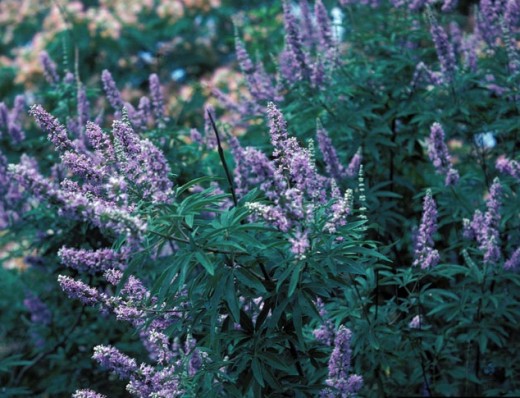Genus Acer
The lobed leaves of some kinds are most beautiful in the spring, some from spring through autumn and some radiate in the fall when they change colors to brilliant yellows, reds and golds. A few Maples have colorful markings on the trunks and larger branches that are most noticeable in the winter when the trees are without leaves. Besides being grown for their beauty, Maples have valuable economic uses. The wood of the Sycamore Maple (Acer Pseudo-Platanus) is white, works well and has a good finish. In Europe it is used for making rollers for washing and calico printing machines and for various kitchen and dairy requisites that require constant washing or scrubbing. Several North American Maples are extremely important for their lumber. There are two distinct types in the lumber trade; Hard Maple and Soft Maple. The former is the wood of the Sugar Maple (A. saccharum) and the latter of the Red Maple (A. rubrum) and Silver Maple (A. saccharinum). The wood is used for furniture, flooring and many other purposes. Some wood of A. saccharum is attractively marked. Names such as Bird's Eye Maple and Fiddleback Maple are applied to distinct types. They are used for cabinetwork and furniture. The wood of the Norway Maple (A. platanoides), the Oregon Maple (A. macrophyllum) and other species is also valued. Maple sugar and syrup are obtained by boiling and evaporating the sap of the Sugar Maple. Many Maple trees are described below in the varieties section.
Pot Cultivation
These trees are easy to grow, except in acidic soil. Regular soil is fine for their cultivation; very poor, sandy soil should be enriched with manure and loam. It is best to plant them in the spring or fall, but it can be done throughout the dormant season when weather permits. Large trees may even be planted with little fear of loss. Most Maples flourish in an open, sunny position. Japanese Maples may be scorched in late spring, especially in exposed gardens. They should be planted in sheltered positions and their roots kept mulched. Japanese Maples may be grown in pots for decoration of the greenhouse in the spring and they're great for planting in tubs. It is only necessary to prune out the crowded branches and shortening the extra long ones. This should be carried out in the summer.Propagation
Seeds can be sown when they're ripe in the fall in a sheltered location outside, or in a cold frame. This is the best method of acquiring new trees. Next to this is the practice of layering the branches that can easily be bent down and pegged into the ground in the summer or they may be air-layered. Grafting may be done in March or budding in July. Seedlings of one of the common kinds are used as stocks.
A. macrophyllum

A. Negundo
VARIETIES
- A. macrophyllum (Oregon Maple), up to 100 ft., F. yellow, fragrant, L. 1 ft. or more across turning bright orange in fall;
- A. Negundo (the Box Elder), 50 ft., L. pinnate w/ 3 or more leaflets;
- A. pennsylvanicum (Moosewood), sm. tree, L. lg., light green turn yellow, twigs & branches are light green striped w/ white;
- A. rubrum (Red, Scarlet or Swamp Maple), F. red & red seeds, L. bright green turn to red & yellow shades, its variety is A. rubrum columnare;
- A. saccharinum (Silver or White Maple), L. deep lobed, silvery beneath turn yellow, its variety is pyramidale;
- A. saccharinum laciniatum (Wiers Maple), L. much divided on pendulous branches;
- A. saccharum (Sugar or Rock Maple), L. turn to red, orange & yellow shades;
- A. saccharum monumentale (Sentry Maple), A. spicatum (Mountain Maple), F. narrow spikes followed by bright red seeds, L. turn orange & scarlet.
- A. Buergerianum (Trident Maple) L. 3 lobed;
- A. campestre (Hedge Maple), 50 ft., slightly corky branchlets;
- A. Davidii, 50 ft., L. turn yellow & purple;
- A. ginnala (Amur Maple), L. turn orange & crimson;
- A. griseum (Paperbark Maple), cinnamon-brown, flaky bark;
- A. nikoense, 40 ft., L. turns to scarlet;
- A. platanoides (Norway Maple), F. greenish-yellow, its varieties Schwedleri, L. open red & change to dark green, Crimson King, L. rich purplish-red, columnare, globosum, cucullatum (Eagle Claw Maple);
- A. Pseudo-Platanus (Sycamore Maple) and its variety erythrocarpum;
- A. tataricum (Tatarian Maple), L. bright green turn yellow.
- A. palmatum
- A. japonicum - atropurpureum, deep purple; aureum, yellow; dissectum, green, finely cut leaves; ornatum, deep red, finely cut; roseo-marginatum, deeply cut leaves edged w/ pink; rubrum, lg. leaves, red when young change to almost green;
- A. japonicum, leaves have seven or more lobes & are bright green turning to crimson; aconitifolium (Fernleaf Maple), deeply divided, green leaves turn ruby red.




